First-Principles Calculation of Copper Oxide Superconductors That Supports the Kamimura-Suwa Model
Abstract
1. Prologue by Hiroshi Kamimura
2. Introduction
3. First-Principles Calculations
4. Calculated Results
4.1. La2CuO4 (LCO): Antiferromagnetic (AF) Insulator
4.2. La2-xSrx CuO4 (LSCO)
4.3. A Metallic Phase with x = 0.125 (the Underdoped Regime)
4.4. The Close Relation between a Spin-Polarized Band in the First Principles Calculations and Hund’s Coupling Spin Triplet in the K–S Model
4.4.1. The Appearance of a Spin-Polarized Band in Cuprates
4.4.2. Relation between the Cu4 dz2 Band and the Hund’s Coupling Spin-Triplet in the K–S Model
4.4.3. Itinerancy of a Hole in the Cu4 dz2 Band
4.4.4. Good Agreement between the First-Principles SCAN Calculations and the K–S Model in the Tight-Binding Form
4.5. Construction of Fermi Surfaces of LSCO with x = 0.125
5. Final Remarks
6. Conclusions
Author Contributions
Funding
Acknowledgments
Conflicts of Interest
References
- Bednorz, J.G.; Müller, K.A. Possible high Tc superconductivity in the Ba-La-Cu-O system. Z. Phys. B 1986, 64, 189–193. [Google Scholar]
- Bednorz, J.G.; Müller, K.A. Perovskite-type oxides-the new approach to high- Tc superconductivity. Rev. Mod. Phys. 1988, 60, 585. [Google Scholar] [CrossRef]
- Anderson, P.W. Resonating valence bond state in La2CuO4 and superconductivity. Science 1987, 235, 1196–1198. [Google Scholar] [CrossRef] [PubMed]
- Kamimura, H.; Sugino, O.; Tsai, J.S.; Ushio, H. Jahn-Teller-effect induced superconductivity in copper oxides: Theoretical developments. In High-Tc Copper Oxide Superconductors and Related Novel Materials, Dedicated to Prof. K.A. Müller on the Occasion of his 90th Birthday; Bussmann-Holder, A., Keller, H., Bianconi, A., Eds.; Springer: Berlin/Heidelberg, Germany, 2017. [Google Scholar]
- Sugano, S.; Tanabe, Y.; Kamimura, H. Multiplets of Transition Metal U., and Ions in Crystals; Chapter X; Academic Press: Cambridge, MA, USA, 1970. [Google Scholar]
- Shima, N.; Shiraishi, K.; Nakayama, T.; Oshiyama, A.; Kamimura, H. Electronic structures of doped (La(1-x)Srx)2CuO4.in tetragonal phase. In Proceedings of the 1st International Conference on Electronic Materials Tokyo, June 1988: New Materials and New Physical Phenomena for Electronics of the 21st Century, Shigaku-Kaikan, Tokyo, Japan, 13–15 June 1988; Sugano, T., Chang, R.P.H., Kamimura, H., Hayashi, I., Kamiya, T., Eds.; Material Research Society: Pittsburgh, PA, USA, 1989; pp. 51–54. [Google Scholar]
- Anisimov, V.L.; Ezhov, S.Y.; Rice, T.H. Singlet and triplet hole-doped configuration in La2Cu0.5Li0.5O4. Phys. Rev. B 1997, 55, 12829–12832. [Google Scholar] [CrossRef]
- Kamimura, H.; Matsuno, S.; Mizokawa, T.; Sasaoka, K.; Shiraishi, K.; Ushio, H. On the important role of the anti-Jahn-Teller effect in underdoped cuprate superconductors. J. Phys. Conf. Ser. 2013, 428, 012043. [Google Scholar] [CrossRef]
- Egami, T.; Toby, B.H.; Billinge, S.J.L.; Janot, C.; Jorgensen, J.D.; Hinks, D.G.; Subramanian, M.A.; Crawford, M.K.; Farneth, W.E.; McCarron, E.M. Local structural anomaly at Tc observed by neutron scattering. 389. In High Temperature Superconductivity; Ashkenazi, J., Barnes, J., Vezzoli, G.C., Klein, B.M., Eds.; Springer Science + Business Media, LLC.: New York, NY, USA, 1991. [Google Scholar]
- Chen, C.T.; Tjeng, L.H.; Kwo, H.; Kao, L.; Rudolf, P.; Sette, P.; Fleming, R.M. Out-of-plane orbital characteristics of intrinsic and doped holes in La2−xSrxCuO4. Phys. Rev. Lett. 1992, 68, 2543–2546. [Google Scholar] [CrossRef] [PubMed]
- Pellegrin, E.; Nücker, N.; Fink, J.; Molodtsov, S.L.; Gutierre, A.; Navas, E.; Sterebel, O.; Hu, Z.; Domke, M.; Kaindl, G.; et al. Greene, Orbital character of states at the Fermi level in La2−xSrxCuO4 and R2−xCexCuO4 (R = Nd2Sm). Phys. Rev. B 1993, 47, 3354–3367. [Google Scholar] [CrossRef]
- Zhang, F.C.; Rice, T.M. Effective Hamiltonian for the superconducting Cu oxides. Phys. Rev. B 1988, 37, 3759–3761. [Google Scholar] [CrossRef]
- Norman, M.R.; Kanigel, A.; Randeria, M.; Chtterjee, M.; Campuzano, J.C. Modeling the Fermi arc in underdoped cuprates. Phys. Rev. B 2007, 76, 174501. [Google Scholar] [CrossRef]
- Kamimura, H.; Suwa, Y. New theoretical view for high temperature superconductivity. J. Phys. Soc. Jpn. 1993, 62, 3368–3371. [Google Scholar] [CrossRef]
- Kamimura, H.; Hamada, T.; Ushio, H. Theoretical exploration of electronic structure in cuprates from electronic entropy. Phys. Rev. B 2002, 66, 054504. [Google Scholar] [CrossRef]
- Kamimura, H.; Eto, M. 1A1g to 3B1g Conversion at the onset of superconductivity in La2−xSrxCuO4 due to the apical oxygen effect. J. Phys. Soc. Jpn. 1990, 59, 3053–3056. [Google Scholar] [CrossRef]
- Kamimura, H.; Ushio, H.; Matusno, S.; Hamada, T. Theory of Copper Oxide Superconductors; Chapter 8.3; Springer: Berlin/Heidelberg, Germany, 2005. [Google Scholar]
- Kamimura, H.; Sugino, O.; Shiraishi, K.; Araidai, M.; Tsai, J.S.; Sakata, H.; Ishida, K.; Matsuno, S. A First-Principles Non-Rigid Band Theory of Correlated Electrons in Copper Oxide Superconductors. 2020; In Preparation. [Google Scholar]
- Furness, J.W.; Zhang, Y.; Lane, C.; Buda, I.G.; Barbielini, B.; Markiewicz, R.S.; Bansil, A.; Sun, J. An accurate first-principles treatment of doping-dependent electronic structure of high-temperature cuprate superconductors. Commun. Phys. 2018, 1, 11. [Google Scholar] [CrossRef]
- Vaknin, D.; Sinha, S.K.; Moncton, D.E.; Johnson, D.C.; Newsam, J.; Safinya, C.R.; King, H. Antiferromagnetism in La2CuO4-γ. Phys. Rev. Lett. 1996, 77, 723–726. [Google Scholar]
- Freltoft, T.; Shirane, G.; Mitsuda, S.; Remeika, J.P.; Cooper, A.S. Magnetic form factor of Cu in La2CuO4. Phys. Rev. B 1988, 37, 137. [Google Scholar] [CrossRef] [PubMed]
- Yamada, K.; Lee, C.H.; Wada, J.; Kurahashi, K.; Kimura, H.; Endoh, Y.; Hosoya, S.; Shirane, G.; Birgeneau, R.J.; Kastner, M.A. Spatial modulation of low-frequency spin-fluctuation in hole-doped La2CuO4. J. Supercond. 1997, 10, 343. [Google Scholar] [CrossRef]
- Zhang, Y.; Lane, C.; Furness, J.W.; Barbiellini, B.; Perdew, J.P.; Markiewicz, R.S.; Bansil, A.; Suna, J. Competing stripe and magnetic phases in the cuprates from first principles. Proc. Nat. Acad. Sci. USA 2020, 117, 68. [Google Scholar] [CrossRef]
- Slater, J.C. The Ferromagnetism of Nickel. Phys. Rev. 1936, 49, 537. [Google Scholar] [CrossRef]
- Connolly, J.W. Energy bands in ferromagnetic nickel. Phys. Rev. 1967, 159, 415. [Google Scholar] [CrossRef]
- Műller, K.A. Large, small, and especially jahn-teller polarons. J. Supercond. 1999, 12, 3. [Google Scholar] [CrossRef]
- Shengelaya, A.; Zhao, G.M.; Keller, H.; Műller, K.A. EPR evidence of Jahn-Teller polaron formation in La1-xCaxMnO3+y. Phys. Rev. Lett. 1996, 77, 5296. [Google Scholar] [CrossRef]
- Lanzara, A.; Saini, N.L.; Brunelnelli, M.; Natali, F.; Bianconi, A.; Radaelli, P.G.; Cheong, S.W. Crossover from large to small polarons across the metal-insulator transition in manganites. Phys. Rev. Lett. 1998, 81, 878. [Google Scholar] [CrossRef]
- Yoshida, T.; Zhou, X.J.; Tanaka, K.; Yang, W.L.; Hussain, Z.; Shen, Z.-X.; Fujimori, A.; Sahrakorpi, S.; Lindroos, M.; Markiewicz, R.S.; et al. Systematic doping evolution off underlying Fermi surface of La2−xSrxCuO4. Phys. Rev. B 2006, 74, 224510. [Google Scholar] [CrossRef]
- Kamimura, H.; Matsuno, S.; Suwa, Y.; Ushio, H. Occurrence of d-wave pairing in the phonon-mediated mechanism of high temperature superconductivity in cuprates. Phys. Rev. Lett. 1996, 77, 723. [Google Scholar] [CrossRef] [PubMed]
- Tsuei, C.C.; Kirtley, J.R. Pairing symmetry in cuprate superconductors. Rev. Mod. Phys. 2000, 72, 969–1016. [Google Scholar] [CrossRef]
- Takagi, H.; Ido, T.; Ishibashi, S.; Uota, M.; Uchida, S.; Tokura, Y. Superconductor-to-nonsuperconductor transition in (La1-xSrx)2CuO4 as investigated by transport and magnetic measurements. Phys. Rev. B 1989, 40, 2254. [Google Scholar] [CrossRef] [PubMed]
- Kamimura, H.; Ushio, H. On the Interplay of Jahn-Teller Physics and Mott Physics leading to the occurrence of Fermi pockets without pseudogap hypothesis and d-wave high Tc superconductivity in underdoped cuprate superconductivity. J. Supercond. Nov. Magn. 2012, 25, 677. [Google Scholar] [CrossRef]
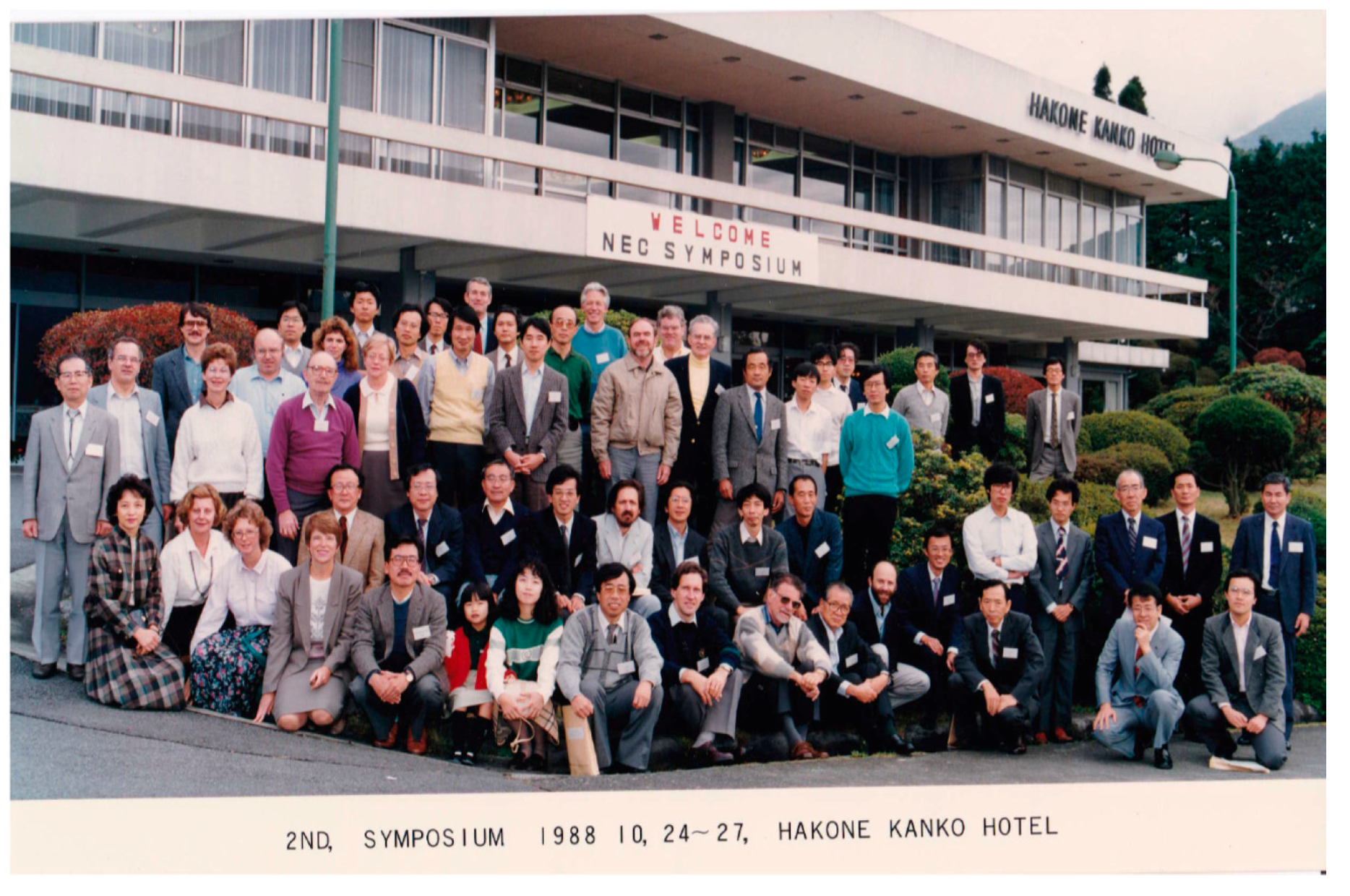
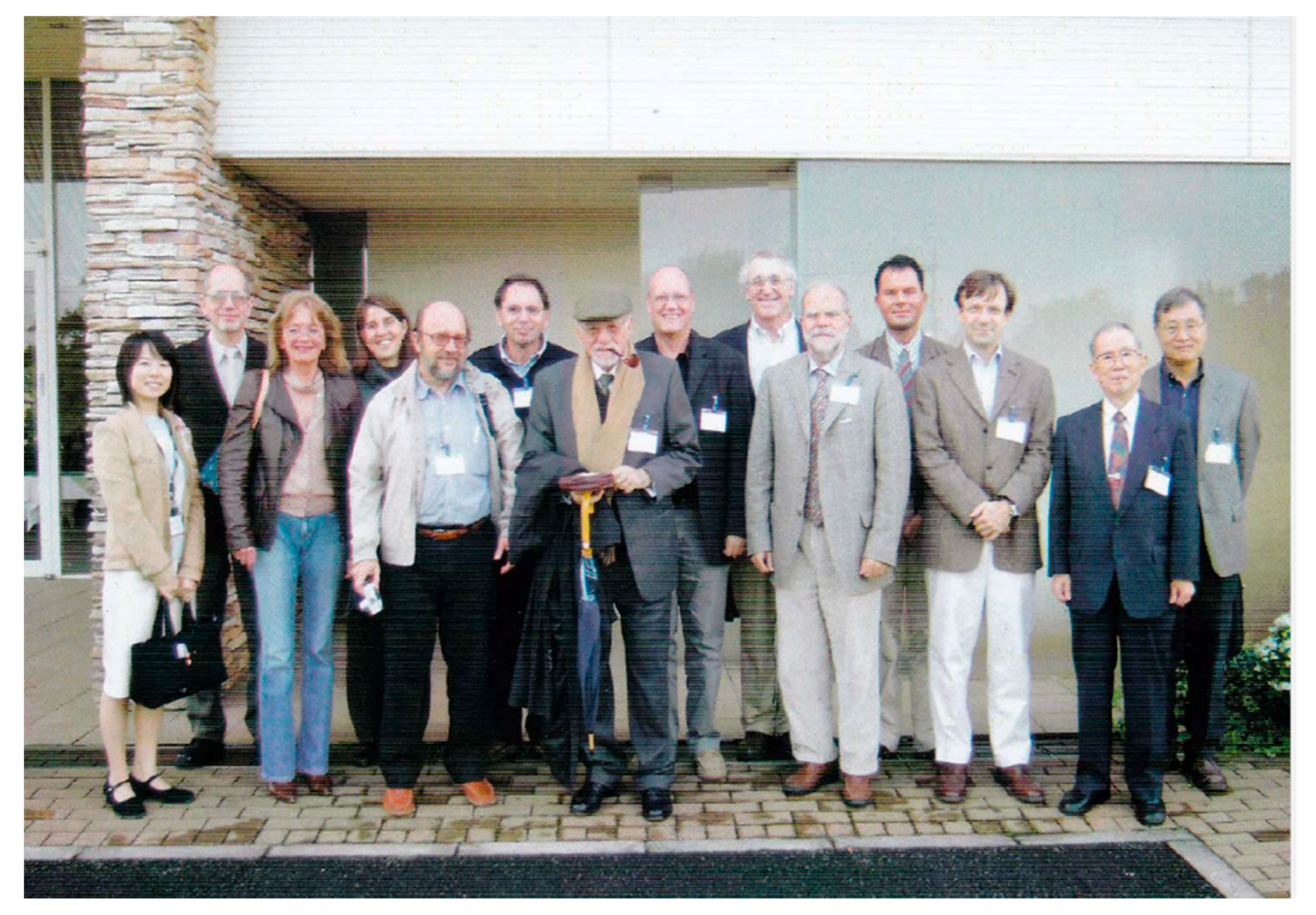
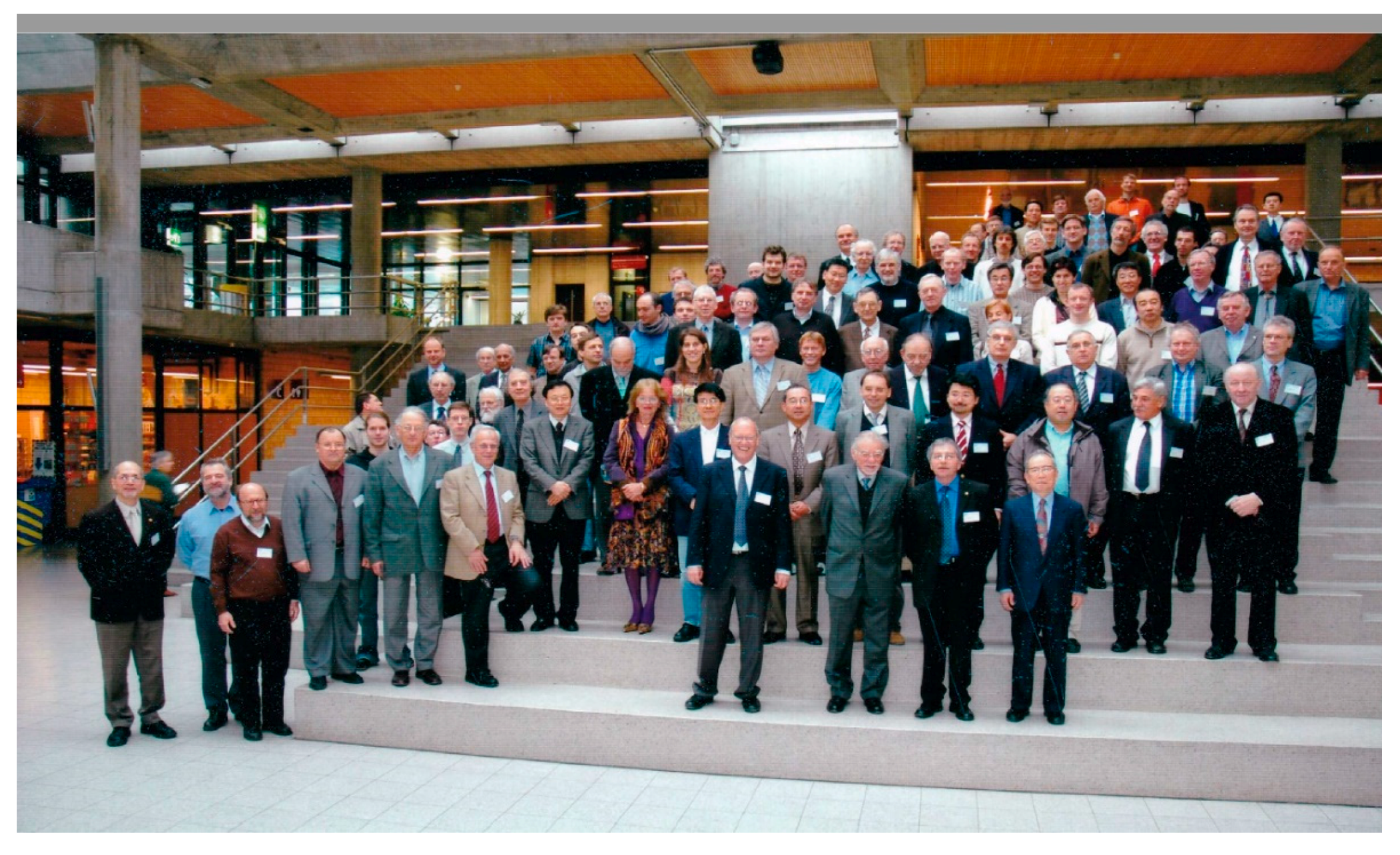
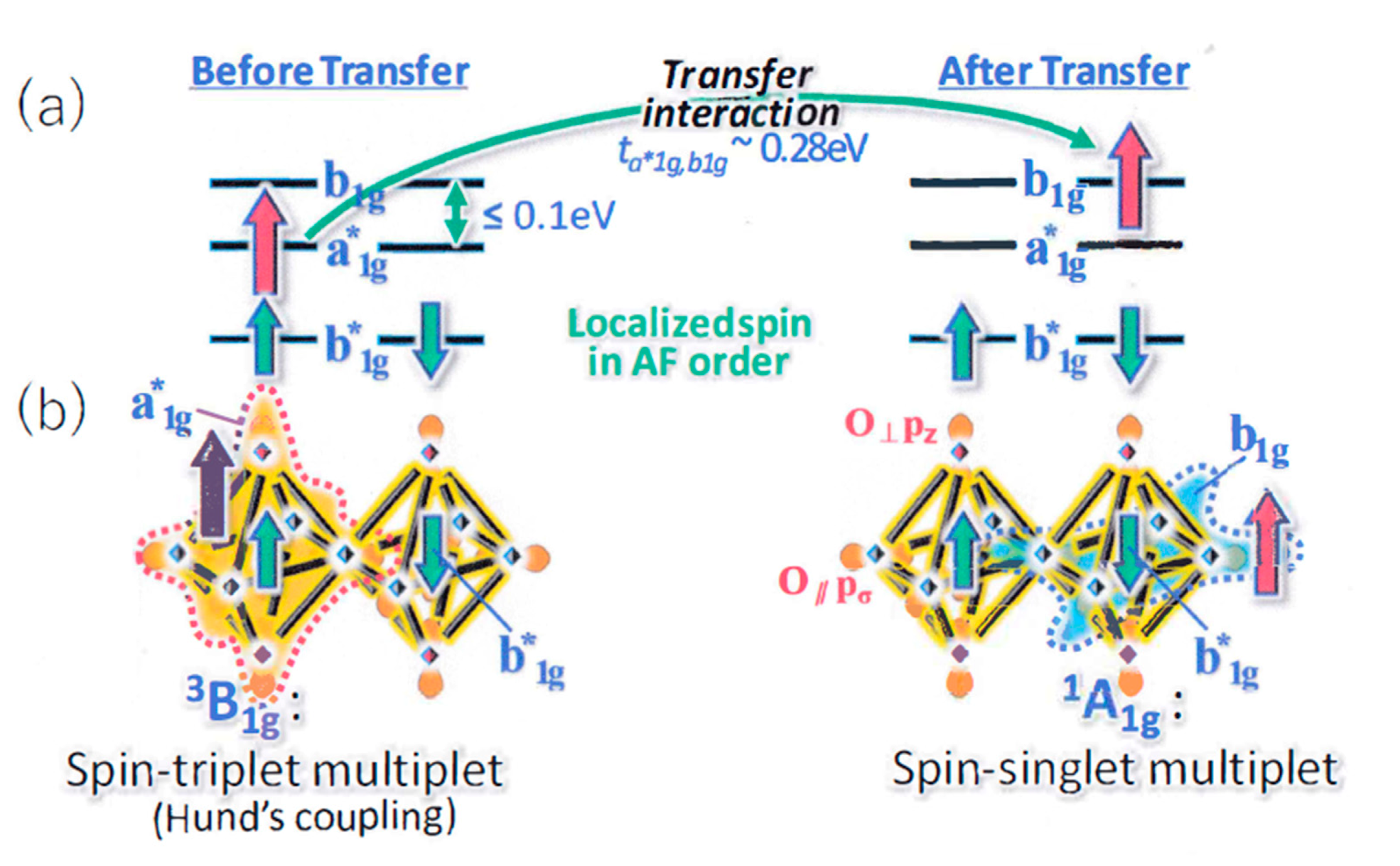
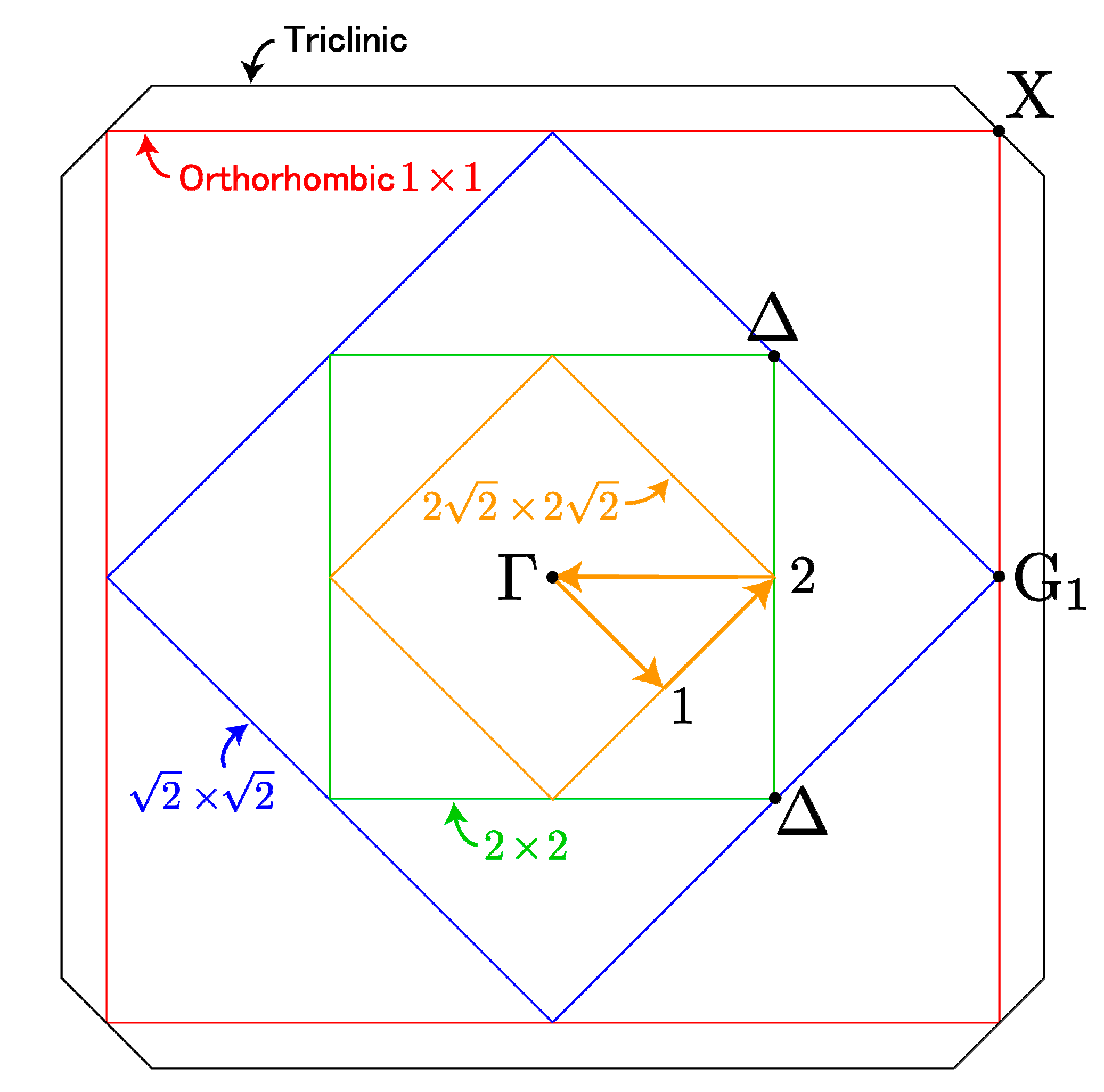
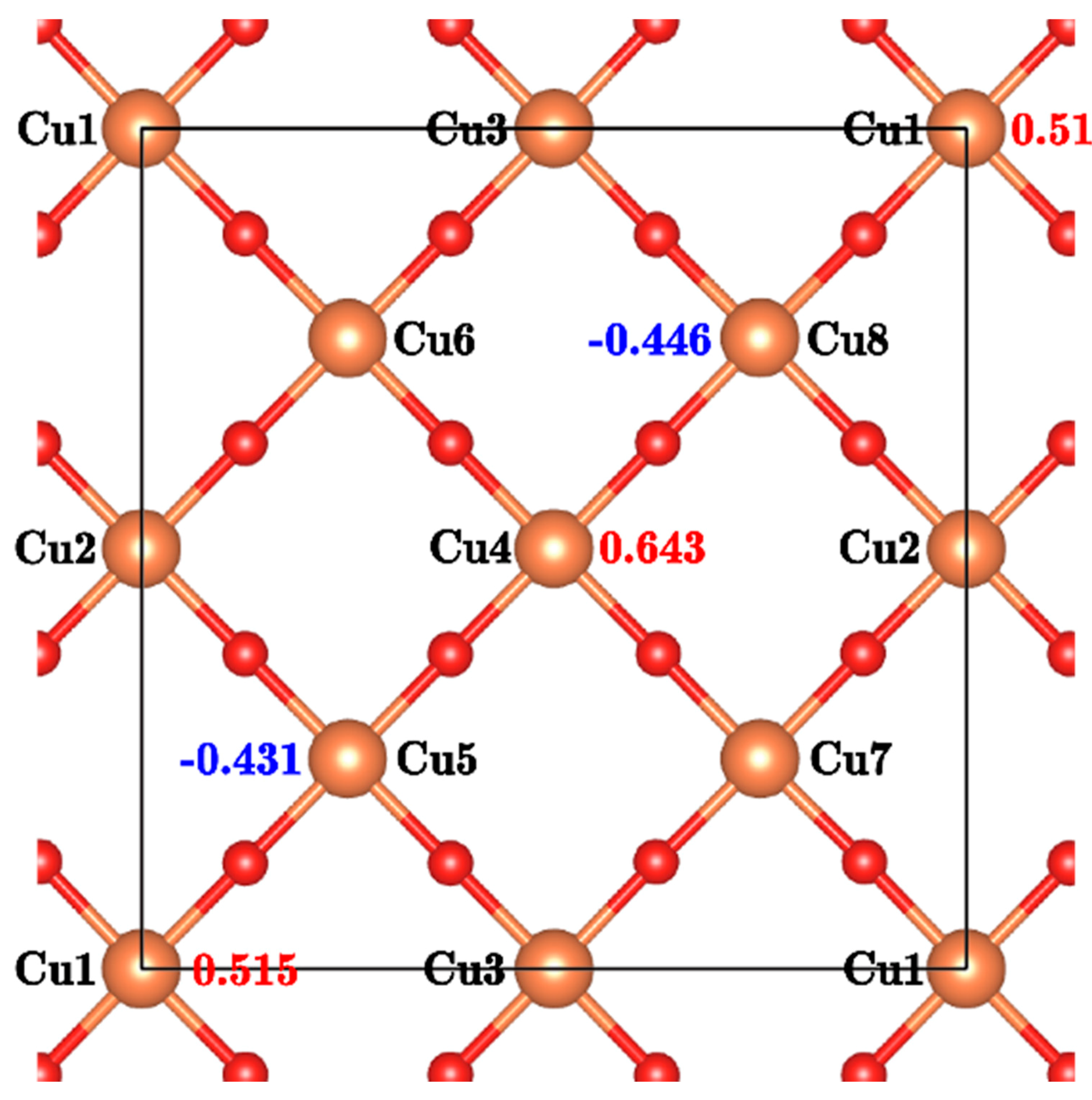
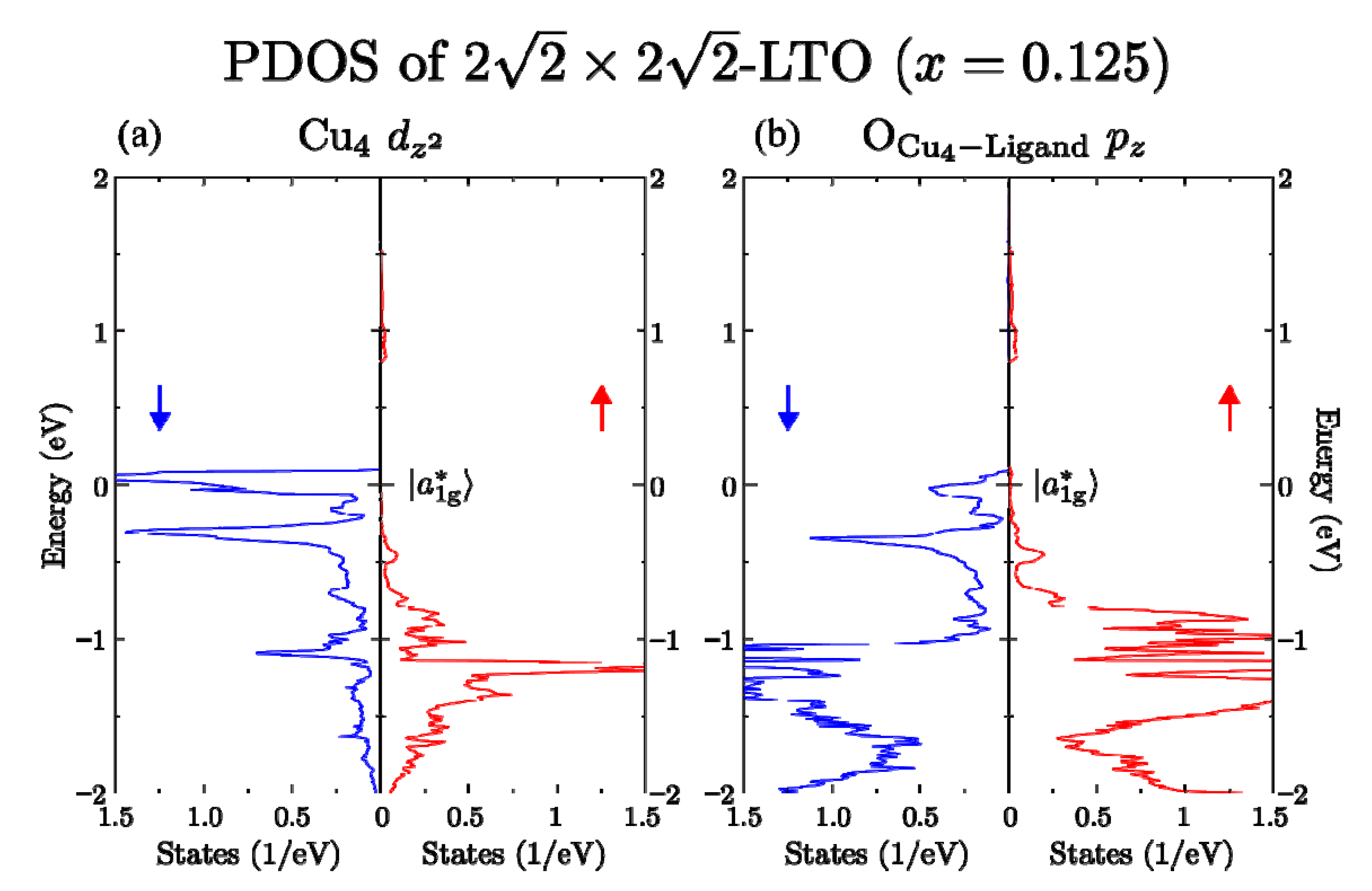
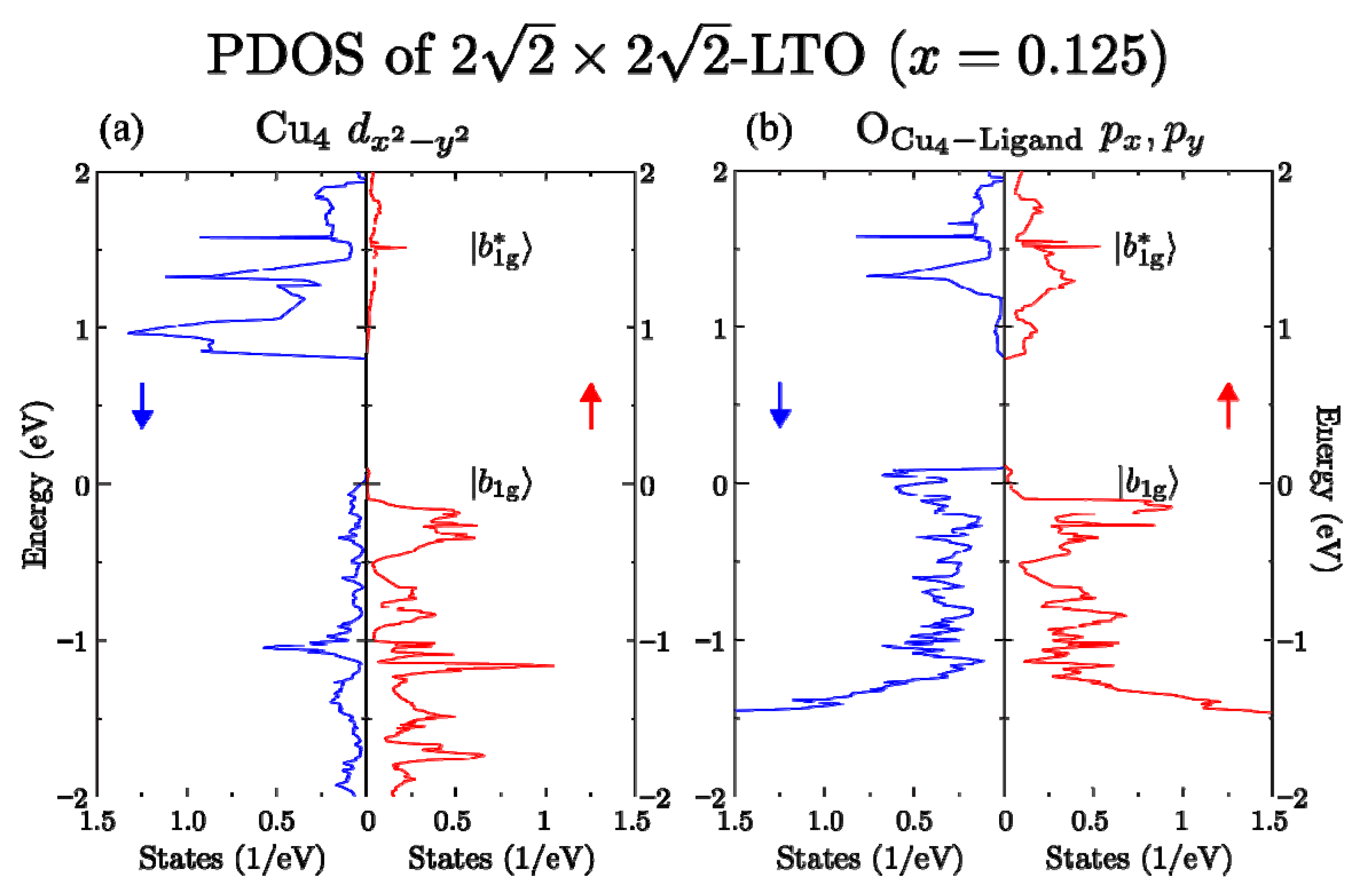
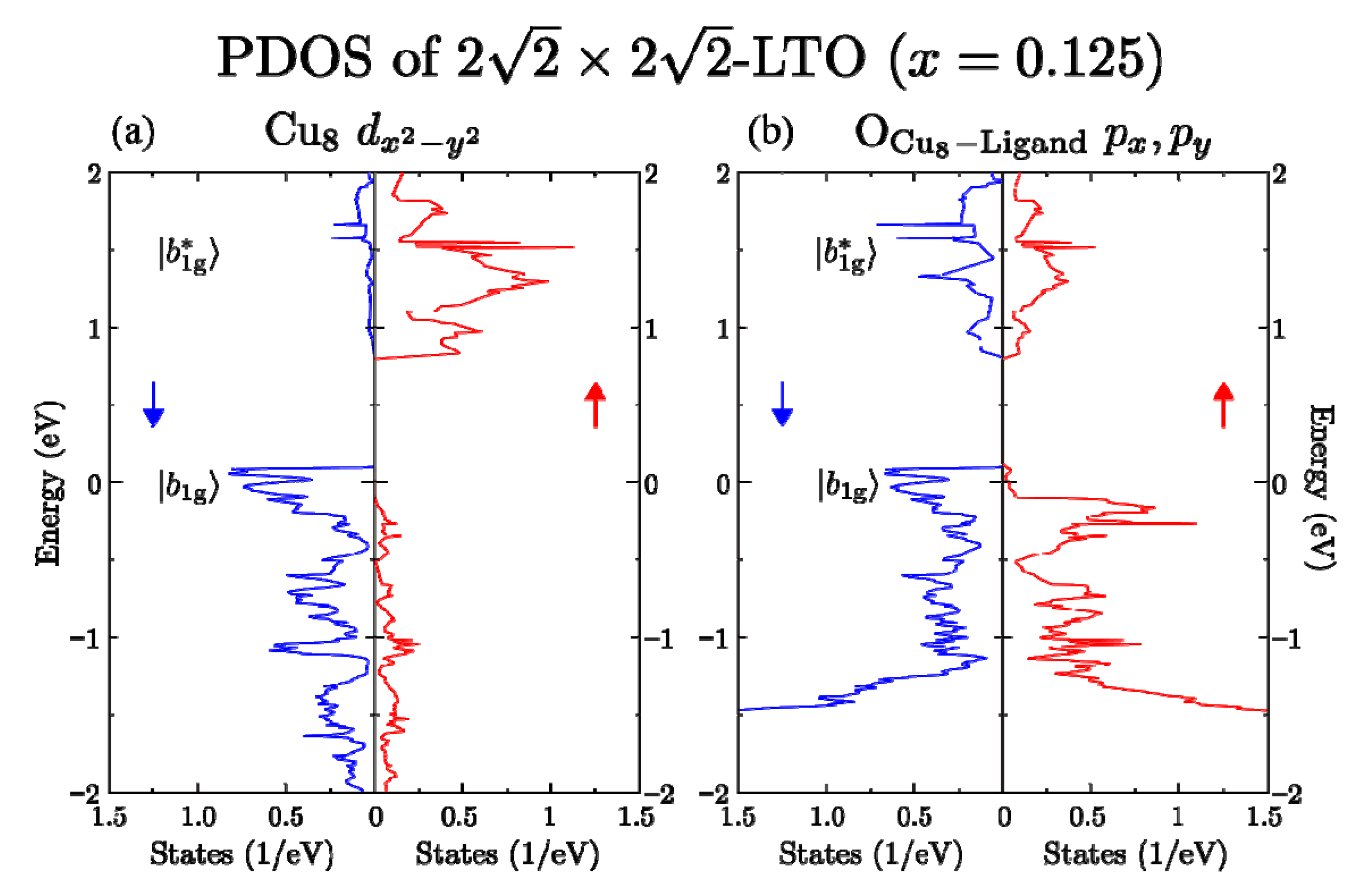
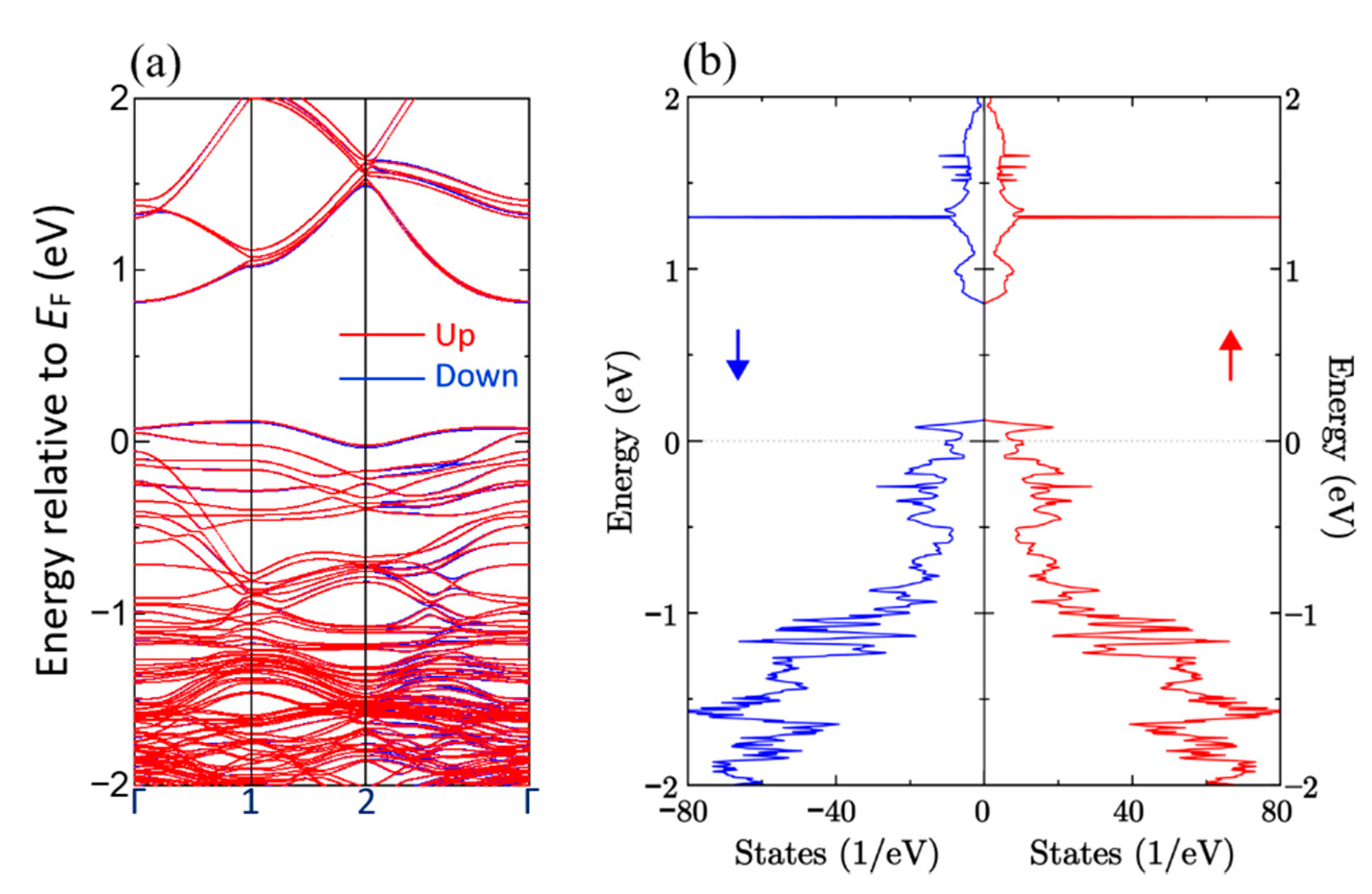
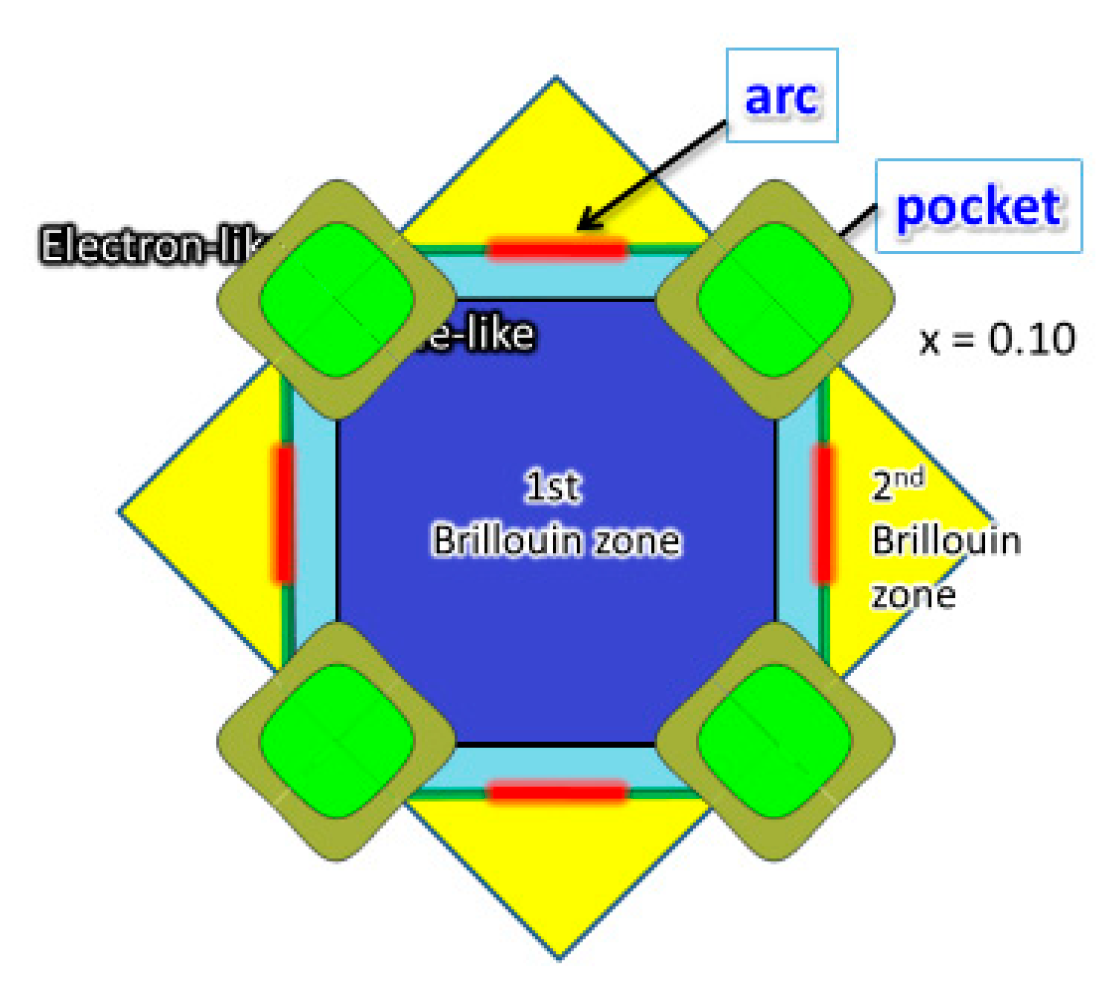
Publisher’s Note: MDPI stays neutral with regard to jurisdictional claims in published maps and institutional affiliations. |
© 2020 by the authors. Licensee MDPI, Basel, Switzerland. This article is an open access article distributed under the terms and conditions of the Creative Commons Attribution (CC BY) license (http://creativecommons.org/licenses/by/4.0/).
Share and Cite
Kamimura, H.; Araidai, M.; Ishida, K.; Matsuno, S.; Sakata, H.; Shiraishi, K.; Sugino, O.; Tsai, J.-S. First-Principles Calculation of Copper Oxide Superconductors That Supports the Kamimura-Suwa Model. Condens. Matter 2020, 5, 69. https://doi.org/10.3390/condmat5040069
Kamimura H, Araidai M, Ishida K, Matsuno S, Sakata H, Shiraishi K, Sugino O, Tsai J-S. First-Principles Calculation of Copper Oxide Superconductors That Supports the Kamimura-Suwa Model. Condensed Matter. 2020; 5(4):69. https://doi.org/10.3390/condmat5040069
Chicago/Turabian StyleKamimura, Hiroshi, Masaaki Araidai, Kunio Ishida, Shunichi Matsuno, Hideaki Sakata, Kenji Shiraishi, Osamu Sugino, and Jaw-Shen Tsai. 2020. "First-Principles Calculation of Copper Oxide Superconductors That Supports the Kamimura-Suwa Model" Condensed Matter 5, no. 4: 69. https://doi.org/10.3390/condmat5040069
APA StyleKamimura, H., Araidai, M., Ishida, K., Matsuno, S., Sakata, H., Shiraishi, K., Sugino, O., & Tsai, J.-S. (2020). First-Principles Calculation of Copper Oxide Superconductors That Supports the Kamimura-Suwa Model. Condensed Matter, 5(4), 69. https://doi.org/10.3390/condmat5040069







